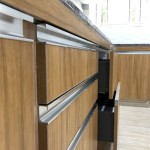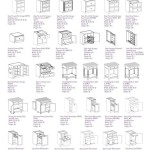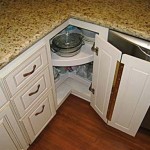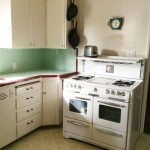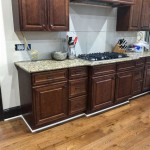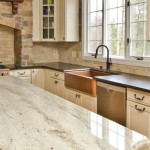Organizing Pots and Pans in Kitchen Cabinets
Kitchen cabinets, particularly those housing pots and pans, often become chaotic repositories of culinary equipment. The accumulation of mismatched lids, varying sizes of cookware, and the sheer volume of items can make finding the right piece for a specific cooking task a frustrating endeavor. Effective organization of these items is therefore crucial for efficient meal preparation and a streamlined kitchen environment. This article explores various strategies for optimizing pot and pan storage within kitchen cabinets, aiming to improve accessibility, space utilization, and overall kitchen functionality.
Before embarking on any reorganization project, a thorough assessment of existing inventory is a necessary first step. This involves physically removing all pots, pans, and lids from the cabinets and meticulously evaluating their condition and frequency of use. Items that are damaged, redundant, or rarely utilized should be considered for donation or disposal. This decluttering process immediately reduces the overall volume of items to be organized, simplifying the subsequent storage phase. Furthermore, assessing the available cabinet space and configuration is vital. Understanding the depth, width, and height of the cabinets, as well as the presence of any interior shelving or dividers, informs the selection of appropriate organizing solutions.
After decluttering and assessing the available space, the next step involves choosing and implementing effective storage solutions. Several options exist, each with its own advantages and suitability depending on individual needs and kitchen layout. These solutions range from simple shelf organizers to more elaborate pull-out systems, and the ideal choice often depends on factors such as budget, DIY skills, and the desired level of organization.
Maximizing Vertical Space with Shelf Organizers and Dividers
One of the most common and cost-effective methods for organizing pots and pans is through the strategic use of shelf organizers and dividers. These tools help maximize vertical space within the cabinets, preventing cookware from being stacked haphazardly and becoming difficult to access. Shelf organizers typically consist of tiered racks that allow pots and pans of different sizes to be stacked neatly on top of each other without scratching or damaging their surfaces. Dividers, on the other hand, separate individual pots and pans, creating dedicated compartments for each item. This prevents them from nesting together and becoming difficult to retrieve.
The selection of appropriate shelf organizers and dividers depends on the depth and height of the cabinets. Adjustable dividers are particularly useful as they can be customized to fit different sized cookware. Consider using heavy-duty dividers made of metal or sturdy plastic to ensure they can withstand the weight of heavier pots and pans. Wire shelving units can also be used to create multiple levels of storage within a single cabinet, effectively doubling or tripling the available space. When implementing this strategy, prioritize placing frequently used items at the front of the shelves for easy access, while storing less frequently used items towards the back.
The strategic placement of lids is another crucial aspect of pot and pan organization. Lid organizers are specifically designed to hold lids vertically, preventing them from cluttering the cabinet space and making it easier to locate the correct lid for each pot or pan. These organizers can be mounted on the inside of cabinet doors or placed on shelves, providing a designated storage solution for lids. Alternatively, consider using a dish rack or similar organizer to create individual slots for lids, preventing them from scratching each other and maximizing space efficiency.
Utilizing Pull-Out Shelves and Drawers for Enhanced Accessibility
For those seeking a more sophisticated and user-friendly storage solution, pull-out shelves and drawers offer significant advantages. These systems allow for complete access to all pots and pans without the need to reach into the back of the cabinet. This is particularly beneficial for individuals with limited mobility or those storing heavy cookware. Pull-out shelves and drawers can be retrofitted into existing cabinets or integrated into new kitchen designs, providing a customized storage solution tailored to individual needs.
When selecting pull-out shelves or drawers, consider the weight capacity and construction quality. Opt for sturdy materials such as solid wood or heavy-gauge metal to ensure they can withstand the weight of the cookware. Ball-bearing slides provide smooth and effortless operation, even when the shelves are fully loaded. The depth of the pull-out shelves or drawers should be carefully considered to ensure that they can accommodate the largest pots and pans in the collection. Dividers can be incorporated into the pull-out shelves or drawers to further organize the cookware and prevent it from sliding around during use.
The configuration of pull-out shelves and drawers can be customized to suit specific storage needs. For example, deep drawers can be used to store larger pots and pans, while shallower drawers can be used for lids, baking sheets, and other flat items. Consider incorporating adjustable dividers to accommodate different sized cookware and maximize space efficiency. The placement of pull-out shelves and drawers should also be carefully considered. Placing them in close proximity to the stovetop or cooking area ensures that cookware is readily accessible during meal preparation.
Implementing Creative Storage Solutions for Lids and Specialized Cookware
Beyond standard shelf organizers and pull-out systems, several creative storage solutions can be implemented to address specific challenges associated with pot and pan organization. These solutions often involve repurposing existing items or utilizing unconventional storage spaces within the kitchen.
One common challenge is effectively storing lids. As previously mentioned, lid organizers specifically designed for this purpose are a worthwhile investment. However, alternative solutions include using a wire dish rack mounted inside a cabinet door to hold lids vertically, or utilizing a tension rod placed horizontally inside a cabinet to create a series of slots for lids. Another option is to store lids inside the corresponding pot or pan when not in use, although this may reduce the overall storage capacity.
Specialized cookware, such as cast iron skillets, woks, and Dutch ovens, often require dedicated storage solutions due to their size, weight, and shape. Cast iron skillets, for example, should be stored in a dry location to prevent rusting. Consider using a sturdy rack designed specifically for skillets, or storing them on a reinforced shelf. Woks, with their rounded bottoms, can be difficult to store securely. A wok ring or stand can be used to stabilize the wok and prevent it from rolling around in the cabinet. Dutch ovens, due to their weight, should be stored on a low shelf or in a pull-out drawer to minimize the risk of injury when lifting them.
Another creative storage solution involves utilizing wall-mounted pot racks or ceiling-mounted pot hangers. These options free up valuable cabinet space and provide a visually appealing display of cookware. However, wall-mounted pot racks and ceiling-mounted pot hangers may not be suitable for all kitchens, particularly those with limited wall space or low ceilings. When installing these systems, ensure that they are securely mounted and can withstand the weight of the cookware. Consider placing frequently used pots and pans within easy reach, while storing less frequently used items higher up.
Another often overlooked area is the storage space above the refrigerator. This space can be utilized for storing large, infrequently used items such as roasting pans and stockpots. However, accessing items stored above the refrigerator can be challenging, so it is important to use a sturdy step stool and exercise caution when reaching for them. Labeling boxes or containers stored in this area can also help to quickly identify the contents and prevent unnecessary searching.
Effective pot and pan organization is an ongoing process that requires periodic maintenance and adjustments. Regularly decluttering the cookware collection, re-evaluating storage solutions, and making necessary adjustments can help to maintain an organized and efficient kitchen. By implementing the strategies discussed in this article, individuals can transform their pot and pan storage from a source of frustration into a streamlined and functional component of their kitchen.
Ultimately, the most effective pot and pan organization system is one that is tailored to individual needs and preferences. Experiment with different storage solutions, assess their effectiveness, and make adjustments as needed to create a system that works best for each individual kitchen. A well-organized pot and pan storage system not only enhances the functionality of the kitchen but also contributes to a more enjoyable and efficient cooking experience.

10 Awesome Tips For Organizing Pots And Pans A Cultivated Nest

Organizing Your Pots And Pans Jamonkey

Organizing Pots And Pans Elite Kitchen Blog

11 Genius Ways To Organize Pots Pans Organization Obsessed

Diy Knock Off Organization For Pots Pans How To Organize Your Kitchen Frugally Day 26 Organizing Homelife

Organizing Pots And Pans In A Corner Cabinet Smallish Home

Get Your Kitchen Organized With These Awesome Ideas For Organizing Pots And Pans Proch Organization Diy Pan Storage Cabinet

Spring Cleaning Diy Organized Pots And Pans Cookware Drawer

Organizing Your Pots And Pans Jamonkey

How To Organize Pots And Pans Smart Ways Cooking Tools
Related Posts

